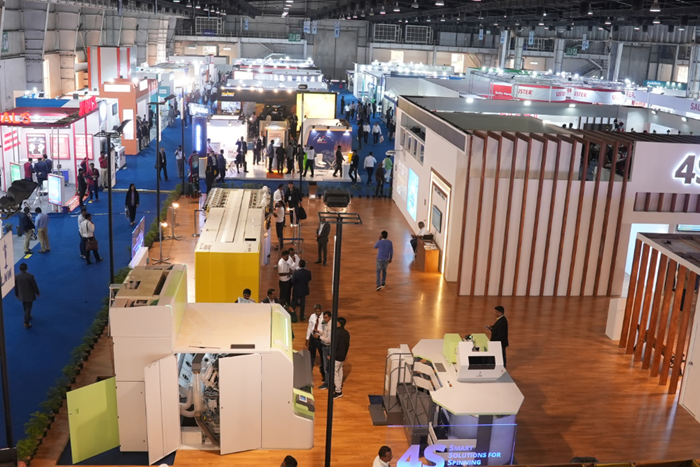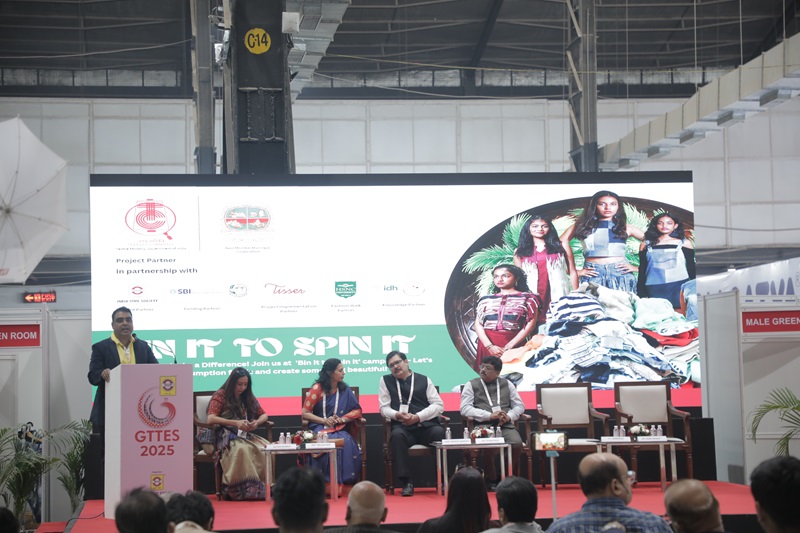FW
In a pioneering step towards sustainable development, Tisser is at the helm of an innovative textile waste recycling initiative in Navi Mumbai, converting discarded fabrics into economic opportunities and environmental benefits. Officially titled "Sustainability in the Textile Value Chain," this collaborative project brings together government bodies, NGOs, and community groups, setting a new benchmark in responsible waste management.
A collaborative vision for sustainability
K V Ganpathy, CEO of Tisser, articulates the project's driving philosophy: "We believe this initiative, in partnership with the Textile Committee, Navi Mumbai Municipal Corporation, SBI Foundation, IDH, and Self-Help Groups (SHGs), marks the first step towards comprehensive stakeholder collaboration." Tisser's pivotal role goes beyond facilitation it spearheads technological innovation and community empowerment at every stage of the process.
The initiative targets the staggering statistic that 43 per cent of India's post-consumer textiles end up in landfills, contributing significantly to greenhouse gas emissions. Ganpathy highlights the urgency: "For every kilo of post-consumer textile, approximately 20 kilograms of carbon dioxide are emitted. In the first phase alone, we aim to prevent 200 metric tons of textile waste from reaching landfills."
Tisser’s Three-Pronged Approach: Technology, training, and trade
At the heart of the initiative lies Tisser’s strategic three-pronged approach:
Technology Integration: Leveraging a dedicated mobile application, Tisser is revolutionizing textile waste collection and sorting. The app streamlines pickup scheduling, tracks waste flow in real time, and enhances operational transparency, laying the technological foundation for efficient waste management.
Capacity Building: Empowering local communities is a cornerstone of the initiative. Tisser is training 80 SHGs, predominantly women-led, in textile waste sorting, processing, and upcycling. The 3,000 sq ft Textile Recovery Facility (TRF) in Belapur serves as the operational hub, fostering skill development and long-term community engagement.
Market Linkages: Tisser goes beyond recycling by creating sustainable livelihoods. By connecting upcycled products to markets, the organization enables SHGs to generate income, turning textile waste into valuable commodities and strengthening the circular economy.
"The entire mechanism involves collecting post-consumer textile waste from residential societies in Navi Mumbai while empowering women through capacity building," explains Ganpathy, underscoring the project's dual impact on environmental sustainability and social empowerment.

Impacting lives, shaping futures
The initiative is projected to create approximately 500 jobs, positively impacting 1,500 families in its initial phase. By engaging 80 SHGs, the project positions women as key players in the circular economy, fostering financial independence and social upliftment. The vision, championed by stakeholders like Raut and Ruprashi, Textile Commissioner, are materializing under Tisser’s strategic leadership. The meticulous process from waste collection in 200 societies to segregation and upcycling at the TRF serves as a replicable model for other cities.
"This is a collective responsibility. Individuals, government agencies, NGOs, and industry partners must come together to tackle this issue," emphasizes Ganpathy.
A blueprint for sustainable cities
Tisser aims to scale this initiative, creating a replicable model for cities across India. By harnessing the power of technology, capacity building, and strategic market linkages, Tisser is not only addressing the pressing issue of textile waste but also proving that sustainable development and community empowerment can thrive side by side.
In the recently concluded Global Textile Technology & Engineering Show (GTTES) 2025, during its B2B session, dedicated to textile waste recycling, emerged as a beacon of hope, showcasing innovative projects and collaborative efforts aimed at transforming the industry's environmental footprint.
The session highlighted the alarming statistics surrounding textile waste, with speakers emphasizing the urgent need for action. A groundbreaking initiative in Navi Mumbai, spearheaded by the Textile Committee in collaboration with the Navi Mumbai Municipal Corporation, SBI Foundation, IDH, and various Self-Help Groups (SHGs), took center stage. This project, aiming to divert 200 metric tons of textile waste from landfills in its first phase, is not just about environmental conservation; it's about empowering communities, particularly women, through sustainable livelihoods.
Addressing Textile Waste: A collective imperative
The session underscored the alarming statistics surrounding textile waste, emphasizing the pressing need for immediate action. K V Ganpathy, CEO of Tisser, articulated the gravity of the situation: "For 1 kilo of post-consumer textile, approximately 20 kg of carbon dioxide gets emitted. Through this project in the first phase, we want to approximately look at 200 metric tons of post-consumer textile waste to be stopped from going into landfills. This is a collective issue for us as a society... The entire mechanism is to collect the post-consumer textile waste from societies located in Navi Mumbai, using women empowerment and capacity building mechanisms."
Empowering women, building communities
At the heart of the project, officially titled "Sustainability in the Textile Value Chain", lies a commitment to women's empowerment. By engaging 80 local SHGs in the collection and processing of textile waste, the initiative is set to generate approximately 500 jobs in the NMMC area. The establishment of a 3,000 sq ft Textile Recovery Facility (TRF) in Belapur will act as a centralized hub for recycling and upcycling activities.
Tapan K Raut, Director (MR) Textile Committee shed light on the project's broader environmental implications: "A t-shirt in the process of production uses more than 2,700 liters of water. The water consumption required for the production of two pieces of cloth is more than 10,000 liters. The textile and clothing industry is one of the major contributors to greenhouse gases. This is the first of its kind project in the world... recycling and upcycling these products will create value chain messages for the world and contribute towards the United Nations' Sustainable Development Goals."
Tisser's role in steering the revolution
Tisser has emerged as the driving force behind the initiative, leveraging its technological expertise and unwavering commitment to sustainability. Their involvement spans three critical pillars:
• Technology Integration: Tisser is optimizing the waste collection and sorting process through a dedicated app for scheduling pickups and tracking waste flow, ensuring efficiency and transparency.
• Capacity Building: The organization is actively training SHG members in textile waste sorting, processing, and upcycling empowering women with essential skills while fostering community ownership.
• Market Linkages: Tisser is facilitating access to markets for upcycled products, enabling SHGs to generate sustainable incomes and ensuring the project's long-term viability.
Ganpathy reinforced this collaborative vision: "We believe that this small step, in collaboration with the Textile Committee, NMMC, SBI Foundation, IDH, and SHGs, is a first attempt at comprehensive stakeholder collaboration."
Public-Private Partnership: A blueprint for success
The involvement of the Navi Mumbai Municipal Corporation has been pivotal in anchoring the project's community-centric approach. Sunil Pawar, Additional Commissioner of NMMC, highlighted the city's waste management efforts: "Our goal is to establish India’s cleanest city... We manage 750 metric tons of waste per day, including 40 to 45 metric tons of textile waste. The principles of reduce, reuse, and recycle are foundational to our approach, and partnerships with citizens and corporate entities are crucial for capacity building."
This synergy between public institutions, private enterprises, and local communities is the bedrock of the project's potential for scalability and long-term impact.
A vision for the future
The project is not just a local endeavour it aspires to serve as a model for similar initiatives across India and beyond. Kartikay Dhanda, Chief Guest and CEO, Secretary, Textiles Committee, Ministry of Textiles, Government of India, emphasized the broader vision: "It's our responsibility to make it safer for our future generations. Once this project is a hundred percent success, I will put a success story on the website, and everybody can adopt it. This is a future that we should, as Indians, be proud of."
The initiative is expected to positively impact around 1,500 families, significantly reduce textile waste in landfills and waterways, and create a ripple effect of economic and social empowerment. The introduction of QR codes on garments further underscores the project's commitment to transparency and sustainable consumption.
The "Sustainability in the Textile Value Chain" project, with Tisser at the helm, is setting a precedent for the textile industry proving that environmental conservation, community empowerment, and economic sustainability can go hand in hand.
Integration of LMW machines at its latest facility, Aarika Spinning is helping Sansar Agro set new standards and produce 40s CCH at 200 GPSS and 40s CCW at 185 GPSS.
The state-of-the-art facility is equipped with the latest LMW machinery. It features aesthetically pleasing color-coordinated beams, matching these machines, alongside color-coded cans and bobbins for streamlined operations.
Sanjay Chaturvedi, Vice President, affirms, LMW machines consistently outperform expectations, even surpassing some European brands. They not reduce maintenance costs but also enhance productivity.
Since its inception in 2003 as a Ginning and Pressing unit, Sansar Agro has transformed into a global textile leader. Driven by vision and innovation, the company’s growth has been significantly expanding due to their investment in LMW spinning machinery.
Dr Kailash Singhania, Chairman, adds, LMW machines not only facilitate the company’s rapid growth but also drive innovation and leadership in quality.
Bangladeshi textile millers are accusing their Indian counterparts of crippling the local industry by ‘dumping’ yarn and fabric into the Bangladeshi market. Showkat Aziz Russell, President, Bangladesh Textile Mills Association (BTMA), claims, this is a deliberate ‘conspiracy; backed by Indian government subsidies.
Millers assert, Indian companies are selling products below production costs both through legal and illegal channels. To prevent this, the Bangladesh Government should levy an anti-dumping duty on these imports and restrict their arrival through land ports, they demand. As per the National Board of Revenue, Bangladesh’s cotton yarn imports rose by 39 per cent and fabric imports increased by 38 per cent rise in 2024, costing Bangladesh billions.
BTMA contends, local mills have the capacity to meet nearly all the domestic demand for export-oriented knit garments, but buyer nominations necessitate some imports. However, they has been a significant increase in local yarn stockpiles, valued at billions of Bangladeshi taka, due to decreased sales, they point out
Millers argue, Indian exporters benefit from government incentives, such as the Remission of Duties or Taxes on Exported Products (RoDTEP) scheme and duty drawbacks, giving them an unfair competitive advantage. They claim, while production costs are similar in both countries, Indian exporters are selling yarn at lower prices than their domestic market, disadvantaging Bangladeshi producers.
Bangladeshi millers are also grappling with rising production costs due to increased gas prices, wages, and inadequate gas supply. They're calling for a reduction in gas prices and lower interest rates to encourage investment. They also criticize the reduction in government incentives for using local yarn, making it less attractive for garment exporters.
These millers warn, without government intervention, factory closures are imminent, threatening the viability of the entire textile industry.

The global apparel market, with economic currents and consumer trends, presents a complex scenario in early 2025. While certain regions saw good growth, others grappled with stagnation and reduction, signalling a period of significant recalibration, indicates Wazir Advisors latest ‘Apparel trade scenario in key global markets and India February 2025’.
Diverging import trends, a tale of two continents
The 2024 apparel import figures reveal a clear difference between the transatlantic markets. The US and EU showed modest growth, with a 2 per cent year-over-year (YoY) increase in imports, reaching $80.3 billion and $88.2 billion, respectively. This suggests sustained, albeit moderate, demand within these major markets.
However, the UK and Japan present a contrasting narrative. The UK experienced a significant 8 per cent YoY decline, with imports falling to $18.4 billion, while Japan saw a 5 per cent drop to $22.5 billion. These declines point to potential economic headwinds or shifting consumer preferences in these regions, necessitating closer observation.
Export dynamics, strength in the East
Apparel exports in January 2025, the data highlights the continued strength of major producing nations. Bangladesh maintained its dominant position, achieving a 6 per cent YoY increase to $3.7 billion. More notably, India showed good growth, with a 14 per cent YoY increase to $1.6 billion. This export performance suggests these countries are effectively capitalizing on global demand, potentially aided by factors such as competitive pricing and increased production capacity.
Retail realities, in-store vs. online
The retail landscape paints a mixed picture, particularly in the US and UK. In the US, traditional apparel store sales experienced a healthy 11 per cent YoY increase in January 2025, alongside a dramatic 25 per cent rise in home furnishing sales. This signifies a potential resurgence of in-store shopping, possibly driven by pent-up demand or evolving consumer preferences.
Conversely, US clothing and accessories e-commerce sales in 2024 fell by 2 per cent compared to 2023. This suggests a possible saturation of the online market, or a movement of consumers back to brick and mortar stores.
The UK presents a similar trend, with a striking 27 per cent YoY rise in apparel store sales in January 2025, reaching £3.8 billion. However, UK clothing e-commerce sales were flat in 2024, mirroring the US trend.
Macroeconomic Shadows: US Uncertainty
The US macroeconomic indicators cast a shadow over the otherwise positive retail figures. January 2025 witnessed a concerning rise in inflation for the fourth consecutive month, reaching 3 per cent. 1 Simultaneously, consumer confidence declined, albeit slightly, to 104.1. These factors raise concerns about potential future economic slowdowns, which could dampen consumer spending on apparel and other discretionary items.
Key highlights
Diverging regional performance: The disparity in import data underscores the importance of regional analysis in understanding global apparel trends.
Export strength: The continued growth of apparel exports from Bangladesh and India demonstrates their critical role in the global supply chain.
Retail resurgence?: The strong performance of physical apparel stores in the US and UK raises questions about the future of e-commerce in this sector.
Macroeconomic impact: The US macroeconomic indicators warrant close monitoring, as they could have significant repercussions for the apparel market.
Thus, the global apparel market is passing through a complex space at the moment marked by both opportunities and challenges. Moving forward, stakeholders must remain vigilant, adapting to evolving consumer preferences and macroeconomic fluctuations to ensure sustained growth.

The Global Textile Technology and Engineering Show (GTTES 2025) wrapped up its three-day event at the Bombay Exhibition Centre, Mumbai, from February 21-23. Organized by the India ITME Society, the event highlighted advancements in textile machinery and fostered global industry collaboration.
Inaugurated with a traditional lamp-lighting ceremony, GTTES 2025 welcomed dignitaries like Navi Mumbai Municipal Commissioner Kailash Shinde and Textiles Commissioner Roop Rashi Mahapatra. International representatives from South Africa, Belarus, Burkina Faso, Botswana, and Myanmar reinforced the event’s global relevance.
Innovation and sustainability in focus
Ketan Sanghvi, Chairman of the Steering Committee, emphasized GTTES as a hub for innovation, with 210 exhibitors from 39 countries showcasing cutting-edge textile solutions. India’s textile sector contributes 13 per cent to industrial production and 2.3 per cent to GDP, making such events crucial for growth.
Shinde addressed sustainability, emphasizing the importance of recycling in managing the 2.4 kilotons of textile waste generated annually in metropolitan areas. He highlighted a pilot project focused on tackling textile waste through recycling and upcycling initiatives.
Key launches and industry events
Major product launches included weaving solutions from Laxmi Shuttleless Looms and digital printing innovations from ColorJet India. The event also hosted symposiums on textile machinery standardization and indigenous innovation, strengthening industry partnerships.
Looking ahead, the India ITME 2026 inauguration set the stage for future advancements. With a successful GTTES 2025, the industry now focuses on leveraging new technologies for sustainable growth.
Karl Mayer has strengthened its position in the denim market with two major orders for its Prodye indigo dyeing systems in Egypt and Turkey. The orders, booked in January, will be delivered in the second half of the year.
In Egypt, a fully integrated denim manufacturer has ordered a Prodye - S slasher dyeing machine to modernize production. This repeat customer, impressed by the machine’s efficiency and sustainability, chose Karl Mayer again. The Prodye -S delivers deeper indigo shades with just eight dyeing boxes, reducing dye bath volume.
Its innovative design also cuts hydro and caustic soda use by 20 per cent, while precise yarn tension control ensures high weaving efficiency. Egypt’s expanding textile sector, supported by government incentives and strong export potential, is driving further investment.
In Turkey, Karl Mayer gained a new customer with an order for a Prodye -R rope dyeing system. The company also purchased a full package of equipment, including creels, Ball Warper, Long Chain Beamer, and Prosize yarn sizing machine. The Prodye -R enhances efficiency with deep indigo shades in nine dyeing boxes and a 20 per cent chemical savings. Its advanced tension control and programmable coiler increase output by up to 20 per cent.
Karl Mayer’s strong market presence in Turkey, built over seven years, continues to grow with innovative solutions. The company also supports customers through its denim R&D center in Rotal, helping manufacturers optimize production and develop new ideas.
The Lenzing Group has welcomed the European Commission’s Clean Industrial Deal, aimed at driving sustainability and industrial competitiveness in Europe. European Commission President Ursula von der Leyen presented the initiative in Antwerp, Belgium, on February 26, 2025, alongside 400 business leaders, including Lenzing CEO Rohit Aggarwal.
Industry leaders are urging EU heads of state to act swiftly ahead of the European Council meeting in March. “Decarbonization, energy volatility, and trade tensions demand urgent collective action,” said Aggarwal. “Europe must incentivize sustainability and turn ambition into results. This initiative strengthens the net-zero industry and green tech manufacturing.” A key challenge is access to clean and affordable energy, vital for industrial competitiveness. Ilham Kadri, President of the European Chemical Industry Council (Cefic), warned that Europe risks losing quality jobs due to slow action. “Nine out of ten calls from the Antwerp Declaration have been addressed. Now we must move from ambition to execution,” Kadri stated.
European industries face mounting pressures, including declining demand, stalled investments, and soaring gas prices. Between 2023 and 2024, manufacturing output fell 2.6 percent, while the chemicals sector saw over 11 million tons of capacity shut down.
The Antwerp Declaration, initially backed by 73 business leaders, now has over 1,300 signatories calling for urgent reforms. Cefic Director General Marco Mensink stressed that EU policies must prioritize energy affordability, investment, and job security. “We need action, not just strategies or plans,” he said.
As geopolitical shifts reshape global markets, Europe’s industries remain committed to supporting policymakers in building a competitive, resilient, and sustainable future.
Jeanologia, a global leader in sustainable textile technologies, is strengthening Bangladesh’s position as the top denim manufacturer by introducing eco-efficient solutions that transform fabric treatment and garment finishing.
At the Dhaka International Textile & Garment Machinery Exhibition (DTG), Jeanologia showcased its latest technologies designed to enhance automation, efficiency, and sustainability in denim production. These innovations help reduce environmental impact while improving productivity for manufacturers.
Jeanologia’s G2 Dynamic technology is changing the denim industry by replacing traditional polluting processes with an ozone-based alternative. This innovation reduces water and chemical use by up to 95 per cent and cuts energy consumption by 80 per cent. By adopting this technology, Bangladesh’s textile industry can enhance its competitiveness while making production more sustainable.
Beyond fabric treatment, Jeanologia offers advanced solutions for garment finishing. Its Laser Technology provides a fully digital and automated system that replaces manual and chemical-intensive processes, improving precision and creativity. G2 Indra, based on Airwash technology, achieves vintage denim looks without using water or chemicals, preserving fabric integrity. e-Flow, a nanobubble technology, applies chemicals with minimal water, reducing waste and improving fabric performance. H2 Zero, a water recycling system, ensures zero discharge in the finishing process, making garment production more sustainable.
By integrating these solutions, Jeanologia is helping Bangladesh maintain its position as a leader in sustainable denim manufacturing.
“With our end-to-end solutions, we aim to transform denim production into a more responsible, automated, and sustainable model. Bangladesh plays a key role in this shift, and our technologies support its global leadership,” said Jean Pierre Inchauspe, Jeanologia’s Business Director in Asia.
Jeanologia celebrates its 30th anniversary in 2025, marking three decades of revolutionizing the textile industry. Since launching laser denim finishing in 1999, the company has continuously developed innovative solutions to reduce water, energy, and chemical use. Its Mission Zero initiative aims to eliminate water and toxic chemicals from garment finishing worldwide.
With over 20 years in Bangladesh, Jeanologia remains a key partner for manufacturers, driving the industry toward a more sustainable, digitalized future.
Karachi will host IGATEX 2025 from April 24 to 26, marking the return of ACIMIT, the Association of Italian Textile Machinery Manufacturers, alongside the Italian Trade Agency. After years, an Italian collective participation is set, with 11 companies three in spinning and eight in finishing. Ten of these are ACIMIT members, including Audaces, Biancalani, Brazzoli, Danitech, Fadis, Ferraro, Mcs, Pinter Caipo, Pozzi Leopoldo, and Zanfrini.
Pakistan’s textile sector has faced a sharp downturn after years of high investment, driven by economic challenges. Reflecting this, Italian textile machinery exports to Pakistan fell from 134 million euro in 2021 to 44 million euro in 2023. However, in the first nine months of 2024, sales rebounded to 34 million euro, up 27 per cent from the same period in 2023.
ACIMIT President Marco Salvade emphasized the importance of maintaining a strong market presence. “Our exports’ recovery confirms the value of our participation in IGATEX 2025. Despite recent challenges, Pakistan remains a key market,” he stated.
ACIMIT and the Italian Trade Agency also support Pakistan’s textile sector through a technological training center at Faisalabad’s National Textile University, established with PISIE. Salvade reiterated that innovation and quality, hallmarks of Italian machinery will continue to enhance Pakistani textile companies global competitiveness.
IGATEX 2025 serves as a crucial platform to reinforce trade ties and drive technological advancements in Pakistan’s textile industry.














